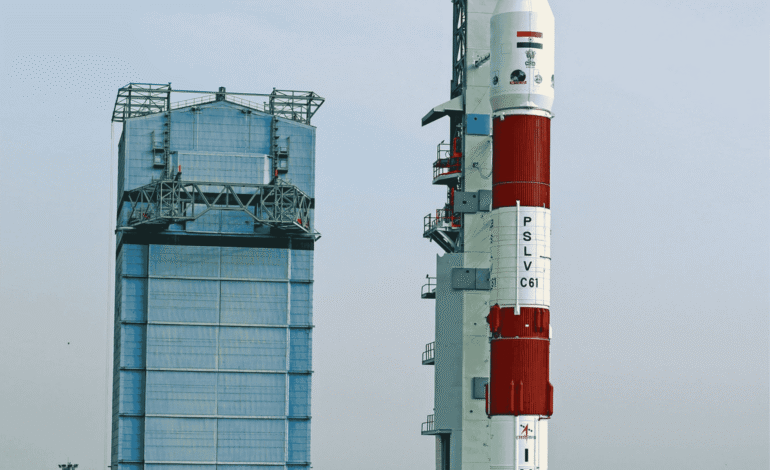PSLV-C61 Mission Fails Due to Pressure Glitch in Third Stage

The Indian Space Research Organisation (ISRO), globally recognized for its cost-effective and ambitious space missions, faced a rare setback with the failure of its PSLV-C61 mission. The launch, which took place on May 18, 2025, from the iconic Satish Dhawan Space Centre in Sriharikota, involved the deployment of the EOS-09 earth observation satellite. Despite a textbook lift-off and promising early-stage performance, the mission could not be completed due to an anomaly in the third stage of the rocket.
The mission was intended to enhance India’s capability in remote sensing and environmental monitoring. EOS-09, equipped with a Synthetic Aperture Radar (SAR), was expected to deliver high-resolution images under all weather conditions, day and night. Unfortunately, a sudden drop in pressure during the third stage of the PSLV rocket compromised the satellite’s deployment into orbit, leading to an incomplete mission.
PSLV-C61 Begins Successfully but Encounters Third Stage Anomaly
At precisely 5:59 a.m., ISRO’s Polar Satellite Launch Vehicle (PSLV) lifted off as scheduled, continuing its legacy as one of the most dependable rockets in the global space sector. Known for its reliable four-stage propulsion system—alternating between solid and liquid fuel—the PSLV has successfully launched over 100 satellites across missions since its inception.
The initial phase of the PSLV-C61 mission went smoothly. The first and second stages performed flawlessly, indicating strong health across major systems. According to mission officials, including project director S. Somanath Narayanan, the third stage ignition was successful as well. However, engineers soon detected an abnormal drop in chamber pressure during the third stage’s operation, a critical phase responsible for propelling the payload into its intended orbit.
“The PSLV is a four-stage vehicle, and up to the second stage, the performance was nominal,” Narayanan stated. “The third stage motor started perfectly, but during its operation, we observed a fall in the chamber pressure, and the mission could not be accomplished.”
This pressure anomaly was enough to divert the rocket from its planned trajectory, resulting in an incomplete deployment of the EOS-09 satellite. ISRO quickly announced that it had initiated an investigation into the incident, reviewing all available telemetry data to identify the exact cause of the pressure drop and possible structural or system faults.
Understanding the Importance of the EOS-09 Satellite
EOS-09 was intended as a repeat satellite, similar in function and design to the previously launched EOS-04 in 2022. Designed for remote sensing, the satellite carried a powerful Synthetic Aperture Radar (SAR) system capable of delivering all-weather, round-the-clock imaging.
These high-resolution SAR images were expected to benefit various sectors:
Agriculture Monitoring: By enabling regular observation of crop growth, irrigation patterns, and soil moisture content.
Forestry and Environmental Applications: Supporting forest cover mapping, illegal logging detection, and biodiversity assessments.
Urban Planning: Facilitating updated mapping of urban sprawl, infrastructure development, and zoning.
Disaster Management: Aiding in rapid damage assessment and resource allocation following floods, earthquakes, or cyclones.
National Security: Offering improved surveillance, border monitoring, and tracking maritime activity in sensitive regions.
With the failure of the mission, these expected capabilities have been temporarily deferred. However, ISRO has not indicated whether a replacement satellite will be fast-tracked in response.
Commitment to Space Sustainability: A Debris-Free Mission Design
One of the mission’s noteworthy features was its focus on sustainability. ISRO had designed the PSLV-C61/EOS-09 mission to be debris-free. A dedicated amount of propellant was reserved for post-mission de-orbiting. This means, once the satellite reached the end of its operational life, it would have used this fuel to lower its orbit deliberately, eventually burning up in the Earth’s atmosphere.
Such practices are increasingly crucial in the modern space environment, where thousands of satellites and remnants from past missions occupy low Earth orbits. Uncontrolled space debris poses significant collision risks to functioning satellites and spacecraft, threatening scientific research, commercial communications, and human spaceflight operations.
By planning for a controlled re-entry of EOS-09, ISRO aligned itself with global best practices, emphasizing the importance of responsible space activity. Although the satellite could not reach its intended orbit, the mission design underscores ISRO’s growing emphasis on sustainability.
Technical Learning and the Value of Setbacks in Space Programs
Space missions operate under extremely complex technical parameters, and even a minor miscalculation or anomaly can affect the entire mission. The failure of PSLV-C61 highlights the importance of continuous innovation, testing, and real-time performance analysis.
While ISRO is known for its remarkably low failure rate, setbacks are part of every space agency’s journey. NASA, ESA, Roscosmos, CNSA, and others have all encountered mission failures. These experiences serve as valuable learning opportunities that fuel advancements in propulsion, structural design, software integrity, and mission management.
ISRO’s immediate acknowledgement of the failure and its pledge to investigate and address the anomaly reflects its commitment to transparency and scientific accountability. In Narayanan’s words, “We are studying the entire performance, and we shall come back at the earliest.”
Such resilience and scientific rigor not only strengthen ISRO’s technical capabilities but also reinforce its role in the international space community.
Global Lessons from PSLV-C61 and Neutral Observations
The failure of PSLV-C61 presents an opportunity for neutral analysis and shared learning across the space science sector. It demonstrates how, despite thorough preparation, missions can face technical disruptions due to the inherent complexity of spaceflight.
Rather than diminishing ISRO’s standing, such events showcase the realities that all space-faring organizations must contend with. Transparency in acknowledging setbacks and committing to corrective action fosters global cooperation and contributes to collective progress in space technology.
Moreover, such challenges encourage cross-border dialogues in research, innovation, and design resilience—especially as nations increasingly share space assets like navigation systems, environmental satellites, and interplanetary missions.
ISRO’s Road Ahead: Continuing Missions and Future Plans
Despite the PSLV-C61 setback, ISRO remains forward-looking. Several key missions are lined up in the near future, including Chandrayaan-4, Aditya-L2 solar observations, and the Gaganyaan human spaceflight program. Additionally, more launches of earth observation and communication satellites are expected under commercial and strategic frameworks.
The organization is also working to strengthen its partnerships with private sector players through NewSpace India Limited (NSIL) and Indian National Space Promotion and Authorization Center (IN-SPACe). These institutions are part of a growing movement to expand India’s commercial space capabilities, open up private participation in satellite launches, and diversify risk.
EOS-09’s capabilities will likely be restored in a future mission, either through a reassembled satellite or an upgraded successor. While the timeline for such a launch is not yet announced, ISRO’s established infrastructure and scientific expertise suggest a relatively swift recovery.
A Setback That Reinforces ISRO’s Strength and Vision
The PSLV-C61 mission serves as a poignant reminder of both the promise and unpredictability of space exploration. Despite a successful lift-off and early-stage performance, the third-stage pressure anomaly curtailed the deployment of EOS-09—one of ISRO’s key payloads aimed at advancing earth observation capabilities.
Yet, within this setback lies an essential truth about science: progress is built on persistence, analysis, and continuous improvement. ISRO has already taken steps to understand the anomaly and will integrate these lessons into future missions.
From a broader perspective, the mission underscores the importance of transparency, sustainability, and international cooperation in today’s space landscape. Whether it’s designing debris-free missions or sharing technical insights from failed launches, ISRO contributes meaningfully to a global culture of responsible space activity.
As the agency moves forward, supported by decades of experience and a strong scientific foundation, it will continue to push boundaries—not just for one nation, but for humanity’s shared journey among the stars.







